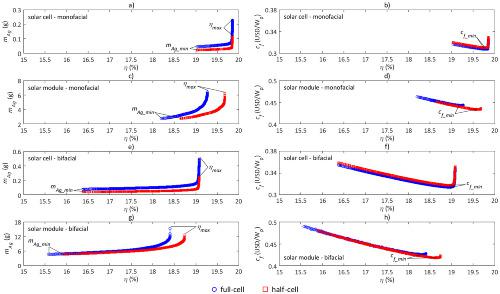当前位置:
X-MOL 学术
›
Prog. Photovoltaics
›
论文详情
Our official English website, www.x-mol.net, welcomes your
feedback! (Note: you will need to create a separate account there.)
PV‐GO: A multiobjective and robust optimization approach for the grid metallization design of Si‐based solar cells and modules
Progress in Photovoltaics ( IF 8.0 ) Pub Date : 2018-08-10 , DOI: 10.1002/pip.3036 Carlos D. Rodríguez-Gallegos 1, 2 , Jai Prakash Singh 1 , Jaffar Moideen Yacob Ali 1, 2 , Oktoviano Gandhi 1 , Srinath Nalluri 1 , Abhishek Kumar 1 , Vinodh Shanmugam 1 , Ma. Luisa Aguilar 1 , Monika Bieri 1 , Thomas Reindl 1 , S. K. Panda 1, 2
Progress in Photovoltaics ( IF 8.0 ) Pub Date : 2018-08-10 , DOI: 10.1002/pip.3036 Carlos D. Rodríguez-Gallegos 1, 2 , Jai Prakash Singh 1 , Jaffar Moideen Yacob Ali 1, 2 , Oktoviano Gandhi 1 , Srinath Nalluri 1 , Abhishek Kumar 1 , Vinodh Shanmugam 1 , Ma. Luisa Aguilar 1 , Monika Bieri 1 , Thomas Reindl 1 , S. K. Panda 1, 2
Affiliation

|
This paper proposes a new optimization approach for the metallization design of solar cells and modules. While previous works have only optimized a maximum of two parameters at a time (which might lead to the loss of the optimal solution), we developed a graphic user interface tool in MATLAB called Photovoltaic Grid Optimizer (PV‐GO) which is able to optimize several parameters in parallel (fingers, busbars, silver pads, and ribbons) with the objectives to enhance the efficiency of the solar cell/module and to reduce the silver consumption. The fabrication cost is subsequently estimated. Two multiobjective optimization algorithms are used: Non‐dominated Sorting Genetic Algorithm II (NSGA‐II) and Multi‐objective Particle Swarm Optimization (MOPSO) as well as a robust condition to ensure that the results are not severely affected by slight changes on the input parameters. The solar cell/module performance is estimated based on the two‐diode model considering the influence of the optimization variables under standard test conditions (STC). To evaluate our methodology, we present the optimization design for industrial Cz‐Si–based p‐type Al‐BSF monofacial and PERT bifacial, full‐cell (15.6 × 15.6 cm2) and half‐cell (15.6 × 7.8 cm2), solar cells and modules. Our methodology provides an optimal design suitable for different market situations that should be considered by the PV manufactures to enhance their electrical performance and reduce their silver consumption, and ultimately improve their profitability.
中文翻译:

PV‐GO:基于Si的太阳能电池和模块的网格金属化设计的多目标且鲁棒的优化方法
本文为太阳能电池和组件的金属化设计提出了一种新的优化方法。虽然以前的作品一次最多只能优化两个参数(这可能会导致失去最佳解决方案),但我们在MATLAB中开发了一种图形用户界面工具,称为光伏网格优化器(PV-GO),可以进行优化几个并行的参数(手指,母线,银垫和碳带),目的是提高太阳能电池/模块的效率并减少银消耗。随后估计制造成本。使用了两种多目标优化算法:非支配排序遗传算法II(NSGA-II)和多目标粒子群优化(MOPSO)以及可靠的条件,可确保输入参数的微小变化不会严重影响结果。考虑到优化变量在标准测试条件(STC)下的影响,太阳能电池/组件的性能是基于两二极管模型估算的。为了评估我们的方法,我们提出了基于工业CzSi的p型Al-BSF单面和PERT双面全单元(15.6×15.6 cm)的优化设计。2)和半电池(15.6×7.8 cm 2),太阳能电池和模块。我们的方法论提供了适合不同市场情况的最佳设计,PV制造商应考虑这些设计,以提高其电气性能并减少其白银消耗,并最终提高其盈利能力。
更新日期:2018-08-10
中文翻译:

PV‐GO:基于Si的太阳能电池和模块的网格金属化设计的多目标且鲁棒的优化方法
本文为太阳能电池和组件的金属化设计提出了一种新的优化方法。虽然以前的作品一次最多只能优化两个参数(这可能会导致失去最佳解决方案),但我们在MATLAB中开发了一种图形用户界面工具,称为光伏网格优化器(PV-GO),可以进行优化几个并行的参数(手指,母线,银垫和碳带),目的是提高太阳能电池/模块的效率并减少银消耗。随后估计制造成本。使用了两种多目标优化算法:非支配排序遗传算法II(NSGA-II)和多目标粒子群优化(MOPSO)以及可靠的条件,可确保输入参数的微小变化不会严重影响结果。考虑到优化变量在标准测试条件(STC)下的影响,太阳能电池/组件的性能是基于两二极管模型估算的。为了评估我们的方法,我们提出了基于工业CzSi的p型Al-BSF单面和PERT双面全单元(15.6×15.6 cm)的优化设计。2)和半电池(15.6×7.8 cm 2),太阳能电池和模块。我们的方法论提供了适合不同市场情况的最佳设计,PV制造商应考虑这些设计,以提高其电气性能并减少其白银消耗,并最终提高其盈利能力。







































 京公网安备 11010802027423号
京公网安备 11010802027423号